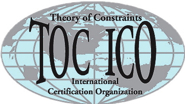What is Throughput Accounting?
There are only three ways to improve the ability of a company to make money: 1) increase throughput, 2) decrease inventory or assets, and 3) reduce operating expense.
Throughput Accounting measures the flow of “real” money through the business. It aproaches accounting from a cash management basis and thereby avoids the many distortions of traditional cost accounting methods (such as cost allocation, product profitability). Throughput Accounting supports day to day and strategic decision making which empowers you to influence the future profitability of the business.
Traditional cost accounting on the other hand was never designed to manage business activity, only report it. It is a historical data reporting tool. Part of the problem with the traditional approach is that cost accounting disguises part of operating expense as inventory. It creates artificial financial values of inventory by "value adding" based on cost allocations to work in process.
The main potential for improvement is in increasing throughput. Both inventory (assets) and operating expense are limited by zero, but the potential to increase throughput is unlimited. Cost accounting methods focus on controlling costs and not generating more revenue through sales. This can lead to management decisions that can harm the business in many ways.
Throughput Accounting provides the tools to move the business towards its goal making more money now and in the future. It provides a small yet powerful set of measures and decision rules that quickly and consistently guide management decision making in the right direction.
![iStock_000007305840Small[1]](/images/stories/graphics/iStock_000007305840Small[1].jpg) Throughput Accounting focuses on increasing the flow and the velocity of money generated through sales through your systems' constraint. It is the only management accounting methodology that considers the systems constraint as the primary factor limiting the performance of the business.
Throughput Accounting focuses on increasing the flow and the velocity of money generated through sales through your systems' constraint. It is the only management accounting methodology that considers the systems constraint as the primary factor limiting the performance of the business.
Within two hours of learning the basics we saved $350,000 by avoiding purchasing capital equipment that did not improve our throughput and we activated a $15,000 service call on our constraint operation that paid for itself in under 3 days. Terry Pember, Best Bar Reinforcements, Melbourne
TOC3 can show you how Throughput Accounting works as a principle-based comprehensive management accounting approach providing real time decision support information to maximise organisational performance.
Within a matter of a day or two you can gain a completely different perspective on product profitability, product mix and target market opportunities that will help you make more money. Contact us
Why traditional Cost Accounting is inadvertantly the enemy of business success?
The widely adopted cost accounting model is a historical financial reporting system. It records and reports financial activity and to some extent performance. It was never designed as a real time day to day management decision making system yet almost everyone tries to make it work as one.
Traditional cost accounting focuses on "optimising" at the local level (e.g. departments, work centres, individuals) in the belief that adding up all local improvements will necessarily sum to a good global result. And herein lies its most fundamental flaw leading to massive contradictions
We know that any system must have a weakest link. The system's overall efficiency (effectiveness) is determined by its weakest link and not by running everything else in the system (resources) to the max! Once we understand this we are looking at business from a completely different perspective and it's empowering.
Example:
Imagine a production flow making widgets requiring a 5 step process and individual resources are required for each step. If the average output of each resource is 10 units per hour what will be the output for the whole flow in an hour?
The answer is not 10. Why?
What does an average mean? In this case it could be 11 units or 8 or 9 units per hour. Averages only make sense if you are dealing with resources individually. But because they are co-dependent, that is the next process can't start until the previous one has finished its processing of the part. This means that all fluctuations in performance are passed down the line giving you an output much less than 10 units per hour.
Say the 5 units each averaged .94% uptime. What will be the percentage output of the entire system? Not .94%. Rather is will be .94x.94x.94x.94x.94 = .733%
Throughput Accounting is the only management accounting method that recognises constraints either internal or external to the business.
Without recognising the weakest link (constraint) cost accounting in not able to help us maximise the speed of money flowing through the business. It is focussed on cost minimisation not Throughput maximisation.
If you wish to know more please write to This email address is being protected from spambots. You need JavaScript enabled to view it. or call 0418207362 or sign up and receive our free Information pack. We run on demand seminars on Throughput Accounting so contact us if you want to attend a session.
Some recommended reading
-
The Measurement Nightmare, Debra Smith
-
The Theory of Constraints and its implications for Management Accounting, Eric Noreen, Debra Smith and James T. Mackey
-
Throughput Accounting, Thomas Corbett
-
Approximately Right Not Precisely Wrong, Yoram Eden & Boaz Ronen
So, if you are using Cost Accounting or Activity Based Accounting it might be time to have a closer look.


